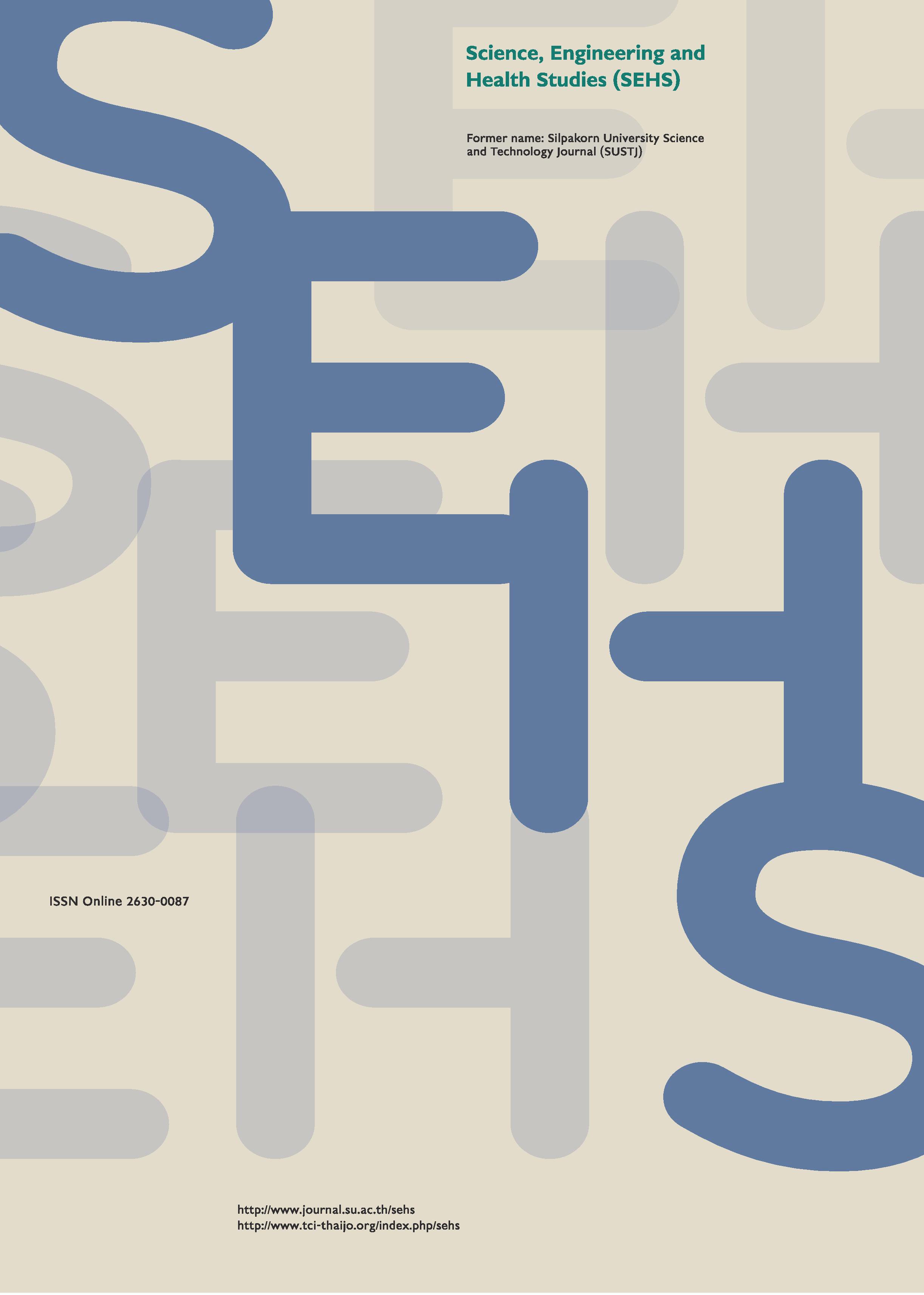Optimal tigecycline dosage regimens in patients infected with carbapenem-resistant Enterobacteriaceae
Main Article Content
Abstract
We aimed to evaluate the minimum inhibitory concentration (MIC) values of tigecycline for carbapenem-resistant Enterobacteriaceae (CRE) and to identify a potential regimen for achieving target values of the area under the curve from 0 to 24 h divided by MIC (AUIC) 10.1 and
6.9. CRE clinical isolates were first obtained from blood specimens from each patient admitted to Phramongkutklao Hospital, Thailand, from October 2017 to October 2018. Tigecycline MIC was assayed using broth microdilution method. The tigecycline dosage regimens for critically ill patients were simulated using the Monte Carlo technique. The tigecycline dose that met 90% of probability of target attainment (PTA) and cumulative fraction of response (CFR) was considered as an appropriate regimen. Sixty-one CRE isolates were included. MIC50, MIC90, and MIC range for tigecycline were 0.5, 1.0, and
0.25-4.0 µg/mL, respectively. Regarding AUIC
10.1 target, the dose of 150-200 mg/day achieved the PTA target for isolates with a MIC of 0.5 µg/mL. Whereas, for AUIC
6.9, a dose of 200 mg/day covered CRE with an MIC of 1.0 µg/mL. For CFR >90%, only a dose of 200 mg/day was capable of achieving the AUIC target of
6.9. None of the studied regimens yielded a CFR >90% for the AUIC target of
10.1. Tigecycline seems to be a possible treatment for CRE; however, tigecycline 200 mg daily may be optimized to cover the CRE isolates with a MIC
1 µg/mL.
Downloads
Article Details
References
Asín-Prieto, E., Rodríguez-Gascón, A., and Isla, A. (2015). Applications of the pharmacokinetic/ pharmacodynamic (PK/PD) analysis of antimicrobial agents. Journal of Infection and Chemotherapy, 21(5), 319-329.
Borsuk-De Moor, A., Rypulak, E., Potrec, B., Piwowarczyk, P., Borys, M., Sysiak, J., Onichimowski, D., Raszewski, G., Czuczwar, M., and Wiczling, P. (2018). Population pharmacokinetics of high-dose tigecycline in patients with sepsis or septic shock. Antimicrobial Agents and Chemotherapy, 62(4), e02273-17.
Chew, K. L., La, M. V., Lin, R. T. P., and Teo, J. W. P. (2017). Colistin and polymyxin B susceptibility testing for carbapenem-resistant and mcr-positive Enterobacteriaceae: Comparison of sensititre, MicroScan, Vitek 2, and Etest with broth microdilution. Journal of Clinical Microbiology, 55(9), 2609-2616.
Clinical and Laboratory Standards Institute. (2018). Performance Standards for Antimicrobial Susceptibility Testing: Twenty-Eight Informational Supplement. Pennsylvania: Clinical and Laboratory Standards Institute (CLSI).
De Pascale, G., Montini, L., Pennisi, M., Bernini, V., Maviglia, R., Bello, G., Spanu, T., Tumbarello, M., and Antonelli, M. (2014). High dose tigecycline in critically ill patients with severe infections due to multidrug-resistant bacteria. Critical Care, 18(3), R90.
Dundar, D., Duymaz, Z., Genc, S., Er, D. K., Irvem, A., and Kandemir, N. (2018). In-vitro activities of imipenem-colistin, imipenem-tigecycline, and tigecycline-colistin combinations against carbapenem-resistant Enterobacteriaceae. Journal of Chemotherapy, 30(6-8), 342-347.
Falagas, M. E., Tansarli, G. S., Karageorgopoulos, D. E., and Vardakas, K. Z. (2014). Deaths attributable to carbapenem-resistant Enterobacteriaceae infections. Emerging Infectious Diseases, 20(7), 1170-1175.
Geng, T. T., Xu, X., and Huang, M. (2018). High-dose tigecycline for the treatment of nosocomial carbapenem-resistant Klebsiella pneumoniae bloodstream infections: A retrospective cohort study. Medicine (Baltimore), 97(8), e9961.
Giamarellou, H., and Poulakou, G. (2011). Pharmacokinetic and pharmacodynamic evaluation of tigecycline. Expert Opinion on Drug Metabolism & Toxicology, 7(11), 1459-1470.
Kaewpoowat, Q., and Ostrosky-Zeichner, L. (2015). Tigecycline: A critical safety review. Expert Opinion on Drug Safety, 14(2), 335-342.
Lertsrisatit, Y., Santimaleeworagun, W., Thunyaharn, S., and Traipattanakul, J. (2017). In vitro activity of colistin mono and combination therapy against colistin-resistant Acinetobacter baumannii, mechanism of resistance, and clinical outcomes of patients infected with colistin-resistant A. baumannii at a Thai university hospital. Infection and Drug Resistance, 10, 437-443.
McGovern, P. C., Wible, M., El-Tahtawy, A., Biswas, P., and Meyer, R. D. (2013). All-cause mortality imbalance in the tigecycline phase 3 and 4 clinical trials. International Journal of Antimicrobial Agents, 41(5), 463-467
Ni, W., Han, Y., Liu, J., Wei, C., Zhao, J., Cui, J., Wang, R., and Liu, Y. (2016). Tigecycline treatment for carbapenem-resistant Enterobacteriaceae infections: A systematic review and meta-analysis. Medicine (Baltimore), 95(11), e3126.
Passarell, J. A., Meagher, A. K., Liolios, K., Cirincione, B. B., Van Wart, S. A., Babinchak, T., Ellis-Grosse, E. J., and Ambrose, P. G. (2008). Exposure-response analyses of tigecycline efficacy in patients with complicated intra-abdominal infections. Antimicrobial Agents and Chemotherapy, 52(1), 204-210.
Pfaller, M. A., Huband, M. D., Streit, J. M., Flamm, R. K., and Sader, H. S. (2018). Surveillance of tigecycline activity tested against clinical isolates from a global (North America, Europe, Latin America and Asia-Pacific) collection (2016). International Journal of Antimicrobial Agents, 51(6), 848-853.
Prawang, A., Santimaleeworagun, W., Changpradub, D., Thunyaharn, S., and Puttilerpong, C. (2019). In vitro antibiotic synergy colistin-resistant Klebsiella pneumoniae. The Southeast Asian Journal of Tropical Medicine and Public Health, 50(4), 703-707. [in Thai]
Roberts, J. A., Kirkpatrick, C. M., and Lipman, J. (2011). Monte Carlo simulations: maximizing antibiotic pharmacokinetic data to optimize clinical practice for critically ill patients. Journal of Antimicrobial Chemotherapy, 66(2), 227-231.
Sheu, C. C., Chang, Y. T., Lin, S. Y., Chen, Y. H., and Hsueh, P. R. (2019). Infections caused by carbapenem-resistant Enterobacteriaceae: An update on therapeutic options. Frontiers in Microbiology, 10, 80.
World Health Organization. (2017). WHO publishes list of bacteria for which new antibiotics are urgently needed. [Online URL:https://www.who.int/news-room/detail/27-02-2017-who-publishes-list-of-bacteria-for-which-new-antibiotics-are-urgently-needed] accessed on April 17, 2019.
Xie, J, Roberts, J. A., Alobaid, A. S., Roger, C., Wang, Y., Yang, Q., Sun, J., Dong, H., Wang, X., Xing, J., Lipman, J., and Dong, Y. (2017). Population pharmacokinetics of tigecycline in critically ill patients with severe infections. Antimicrobial Agents and Chemotherapy, 61(8), e00345-17.
Xu, Y., Jin, L., Liu, N., Luo, X., Dong, D., Tang, J., Tang, J., Wang, Y., You, Y., Liu, Y., Chen, M., Yu, Z., Hao, Y., and Gu, Q. (2019). Evaluation of the ratio of the estimated area under the concentration-time curve to minimum inhibitory concentration (estimated AUIC) as a predictor of the outcome for tigecycline treatment for pneumonia due to multidrug-resistant bacteria in an intensive care unit. International Journal of Antimicrobial Agents, 82, 79-85.


